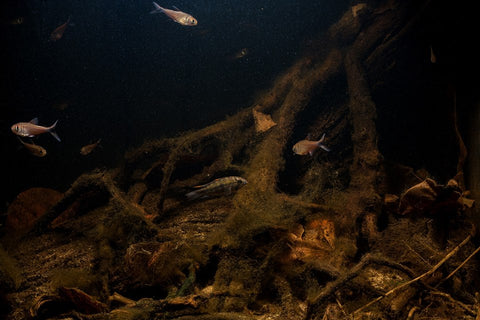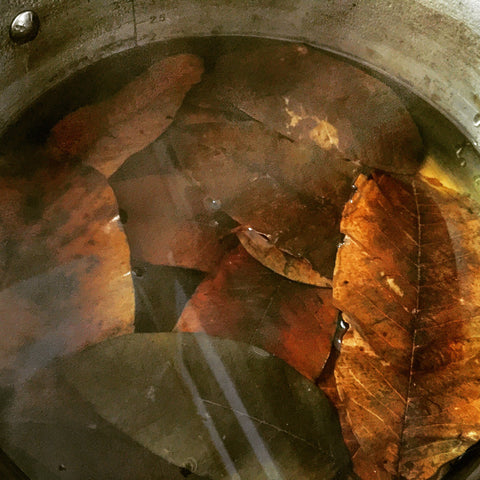- Continue Shopping
- Your Cart is Empty
Notes on the "maturity" of botanical-influenced aquariums
Do you ever look at your aquariums over time and sort of evaluate how they've evolved?
With a botanical-style aquarium, this is not only interesting, but it's a useful practice as well, as we develop the body of knowledge, experience, and technique associated with the long-term maintenance of these systems. And by doing this sort of periodic evaluation, you'll also be able to develop a "feel" for how your particular aquarium performs over the long haul.

For example, in our office 50 gallon leaf litter system, which has been up and running just about one year now, we've noticed some interesting trends. The first thing we noticed when we started adding leaves is that, as we built up the "litter bed", what we excepted was an explosion of nasty biofilms and algae all over. Interestingly enough, the biofilm phase" only took place after a couple of weeks, and was remarkably limited and short-lived.
We also noticed that the biofilms seemed to be confined to specific leaves that were prepared in a specific fashion, too! In our observations, leaves that were steep in boiling water tend to recruit substantially less biofilms that those that are simply rinsed and tossed into the aquarium, although your "mileage may vary" as they say.
In our experience, the leaves with thicker "cuticle layers", like Jackfruit and Magnolia, seem to "recruit" the biofilms a little more rapidly; a little more significantly than the "thinner" leaves like Guava, Catappa, etc. And, because of their more "durable" outer layer, the aforementioned leaves are actually a bit easier to work with if you're inclined to physically remove the biofilms from the surfaces (ever the patient type, when I conduct "physical biofilm removal" from leaves, I tend to use a small plant tweezer, others opt for a soft toothbrush).
Observing this aquarium carefully over time as it matures has once again confirmed my ideas about which leaves tend to last the longest before ultimately softening and decomposing. There were no surprises here. From quickest to decompose to longest-lasting, my experience time and again has shown the following order:
-Catappa, Guava, Loquat, Jackfruit, Magnolia
Sure, there are always a few random specimens of say, Guava, which linger for a month or so longer than one would expect, but on the whole, this assessment seems pretty reliable and valid.
The other thing that I've noticed is that the tint of the water tends not to diminish over time, even with water changes. And this is due to a couple of factors, the first being that the water I utilize for changes has a few Catappa leaves steeping in the containers, and the second factor being that the leaf litter bed in the aquarium itself is continuously being "topped off" with an average of 2-4 new leaves per week. Which leaves I use are dictated by which ones are decomposing, and what sort of "aesthetic" I'm feeling at the time. This process of adding new leaves is analogous to what happens in nature, where new leaves are more or less continuously falling into the streams and rivers, replacing ones that decompose.

I'm asked a lot if I remove leaves and botanicals that decompose, and my answer is "It depends."

If you don't mind the look of crumbling leaves and botanicals (I don't), I say to leave 'em in! This is a very natural look and mimics the natural processes that occur in rivers and streams quite accurately. On the other hand, if you simply can't handle crumbling "Terra Sorrindo" in your tank,for example, feel free to yank them out and replace them as you see fit!
That's the beauty of this kind of aquarium: There is a fair amount of flexibility and freedom to manipulate the physical appearance of the tank regularly without having too much radical influence on the chemical and overall environmental parameters, if you replace things "as they go."

The other observations I have made as my botanical-influenced aquariums mature is that they are surprisingly stable, in terms of water chemistry parameters, fish population, and general appearance over time. Oh, sure, you will get a different "look" when you throw in some new leaves or botanicals, but the overall aesthetic is remarkably consistent without being mundane over time.

Sort of like a planted aquarium that you prune regularly. It just looks "fresh" without being to radically redone. Smaller, controlled, regular moves as opposed to rapid, radical ones will almost always yield better results.
One of the things that I believe has had significant impact on the overall quality and health of my botanical systems has been to incorporate good water movement into the aquarium. In other words, having filter output or additional movement provided by powerheads and such directed so that water is in motion around all levels of the tank, especially towards the bottom where the leaves are. This will assure good oxygenation and overall movement of the area where leaves tend to break down and detritus could potentially accumulate, keeping the pH from "stratifying." How much flow to get down there really depends upon a range of factors, such as the kinds of fishes you're working with, how much movement you can get in there without knocking everything all over, and the overall "look" you are trying to achieve (a fast-moving river versus a meandering Igarape or near-stagnant Asian blackwater pond, for example...) in your aquarium.
In terms of parameters such as pH, alkalinity, nitrate, and phosphate, after some initial "settling in" I've found well managed botanical aquarium to be surprisingly stable, and absolutely no more difficult to maintain than any other type of specialized aquarium. At least as easy as an "Mbuna" aquarium, and certainly less of a headache than a reef aquarium, these tanks are really quite easy to manage if you develop- and stick to- a regular schedule of water changes, botanical replacements, and filter media changes. I've found that weekly water changes work perfectly for me.

Really, as I've said repeatedly, the most difficult part of creating and managing a botanical-style aquarium is to make that mental "stretch" and to accept that the appearance of this sort of aquarium will be substantially different than any other that you've owned before. Understanding that decomposing leaves, formation of biofilms, algae, and tinted water are both desirable and normal is the key.

The term "natural aquarium" is far more applicable in this context than in many others, in my humble opinion. Knowing that what you might initially perceive as the most "aggravating" stuff (like the initial appearance of biofilms) is part of the evolving processes that occur in both our aquariums and nature, and that the worst of them are typically transitory- will give you an even greater appreciation and love for this type of very natural aquarium.

As you gain more familiarity with the idea of running a botanical-influenced aquarium, you'll no doubt make some of your own interesting and useful observations, develop techniques, shortcuts, and theories. This is the beauty of being actively involved in what is sort of the "ground floor" of a newer "movement" within the aquarium hobby. Every observation counts. Sharing is huge. Every new aquarium set up helps add to the overall body of knowledge, advancing the state of the art and providing valuable inspiration to others.
And that's what it's all about!
Until next time...Watch your aquarium evolve and mature. Stay focused on the big picture. Stay engaged. Stay curious. Stay invigorated.
And stay wet.
Scott Fellman
Tannin Aquatics














Scott Fellman
Author